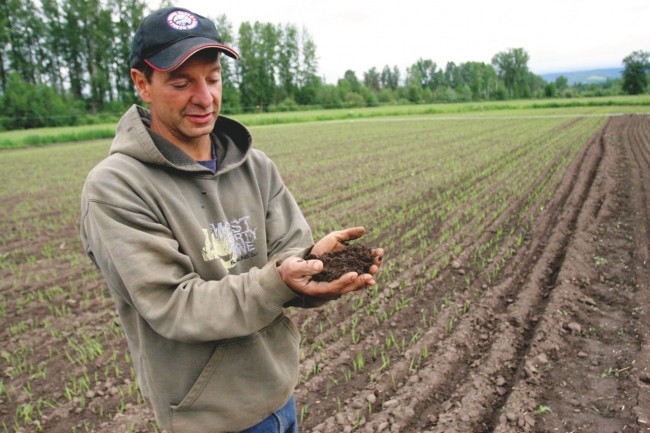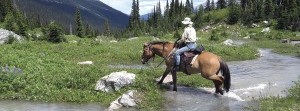
Breaking Ground: Getting down and dirty with the Groundbreakers Collective
Organic farmer Joe Hug stands in the dirt on his small farm just a few kilometres out of Smithers. In his hand he holds a scoop of soil he’s grabbed from the ground by his feet. “Last week I had a kindergarten class down here,” he says. “I held up a handful of dirt like this and asked them, ‘Which has more value: dirt or gold?’ Some said gold,” he laughs, “but most of them said dirt.” According to Hug—and to local non-profit group Groundbreakers Collective—the ones who said ‘dirt’ are on the right track.
Value, he explains, is a lot more than what economists might typically link to dollars and cents. “We’re taught to look down on dirt,” Hug explains. “But dirt is one of the most important things on Earth!”
Hug’s farm is one of 10 producers growing and preserving for the collective this year, from Suskwa and Kitwanga to Quick, with a Burns Lake harvester who roams from Haida Gwaii to east of Burns Lake. The ethic behind the Groundbreakers movement is that there is intrinsic value not only in eating local, organic, pesticide-free food, but also in the actual act of growing and gathering that food. The process—not just the taste and the health benefits—is part of what makes it good. In the Bulkley Valley, that’s where the Groundbreakers’ Harvest Box program comes in.
Vegetable box programs are becoming more commonplace. In bigger cities, they are usually pretty straightforward: you sign up, pay, and once a month (or in some cases once a week) you get a box of assorted vegetables.
The Harvest Box is that, plus a bit more. The program is based on something called community supported agriculture, which brings small farmers and consumers together, facilitating a convergence where farmers get help on the farm and consumers take away more than just food—they also get an experience.
Going local
The food itself is obviously a pretty important part of the program. Harvest Box participants receive a monthly box of assorted produce through the winter. Eating local food isn’t exactly a new concept, but it is gaining popularity.
Eating local is healthy, supports the local economy, strengthens community, and—perhaps most importantly—it feels good. “It’s great to know where my food is coming from,” says Theresa deGroot, who participated in the program last year. “I love to know that I am supporting our local producers and getting to know them.”
“For me, it’s a very community-minded way to spend money,” says Harvest Box coordinator Dawn Hanson. She goes on to say that by supporting projects like this and by shopping at the farmer’s market, small-scale local agriculture becomes more sustainable. “We’re showing that food-producing land is valuable and important.”
Hug says it might be hard for some people to understand why small-scale organic farming is so important because we’re often confronted with conflicting information. “A society that makes us wear seatbelts wouldn’t let us eat poison!” he says sardonically. But, he continues, that’s exactly what pesticide-treated produce is—poison. “I inherited this land six or seven years ago,” says Hug. “I’ve travelled the world and I’ve come to realize that land is a responsibility.”
The Harvest Box program promotes organic produce, grown locally, and the feedback has been positive. “People are pretty forgiving when they see holes in the spinach,” says Hug.
Dirt therapy
When you sign up for a Harvest Box with Groundbreakers, you also commit to a certain number of volunteer hours. There are a few options—more money, less hours or less money and more hours—but whatever you choose, you will end up spending some time getting your hands dirty.
That’s value right there, says Hug. “It’s almost therapy for some people,” he says and describes a few of his more regular volunteers who come down simply for the opportunity to spend a couple of hours digging in the dirt. “There’s something about it that’s really good. Getting down on the ground, getting dirt on your hands. It feels good.”
Volunteers won’t be subjected to anything too strenuous or beyond their ability. “Depending on when it is, they can expect to do some weeding, maybe some planting,” says Hug.
In the fall, volunteers help with the harvest. “At Joe Hug’s farm, I cut broccoli off the stalk in the field, pulled carrots and beets from the ground, took carts full of cabbage to the area where veggies are cleaned and packed into the cellar, cut spinach and packed it into plastic bags, cut tops off beets, washed vegetables…” says deGroot. “I was amazed at all the things we did in one afternoon.”
Volunteers can expect to meet the farmer face-to-face, and create a tangible connection between the food they’ll be eating through the winter and the work they did in the spring or summer. “Customers gain a better sense of where their food comes from,” says Hanson.
“Bryan and I went to Joe Hug’s place in September and spent five hours each,” deGroot recalls. “It was a beautiful fall day and there were other volunteers there, so we met other great people. There was no boredom as we went from one crop to another, harvesting, washing, all the while talking and sharing stories. The time went quickly.”
Weather effects
“Volunteers also get a better connection between their environment and the weather and what that means for the food,” says Hanson, explaining that last year’s weather had a pretty significant impact on growing in the Bulkley Valley. Everyone who participated in the Harvest Box program witnessed those effects firsthand in the field, and then again when they received their food box through the fall and winter. “These links are really important.”
She describes volunteer days as being less like work and more like an afternoon adventure. “Farmers provide refreshments. You get to meet other box holders.” Many volunteers choose to bring their kids along, says Hanson, which is encouraged. “Most kids work hard enough that their hours count too!”
Volunteer hours don’t necessarily have to go into work-bees. There are other opportunities to get involved, including box packing and helping at canning workshops. “If you want to learn about canning, that’s a great way to get your hours in,” says Hanson.
“I think Groundbreakers did a fantastic job in their first year, along with the producers, especially since last summer was not the greatest for producing vegetables,” says deGroot.
She sums it up nicely. “Local food may cost a bit more, with the challenges of growing in our northern climate, but I like to think that I am personally decreasing my dependence on fossil fuels for transportation as well as keeping jobs local for feeding local people.”
Hanson agrees. “All this is important. We need to be able to sustain ourselves a bit better and have a greater awareness of what’s around us.”
And hey, it doesn’t hurt that the Harvest Box program helps you meet other like-minded folks, hang out with friendly farmers, and eat great food all winter.



